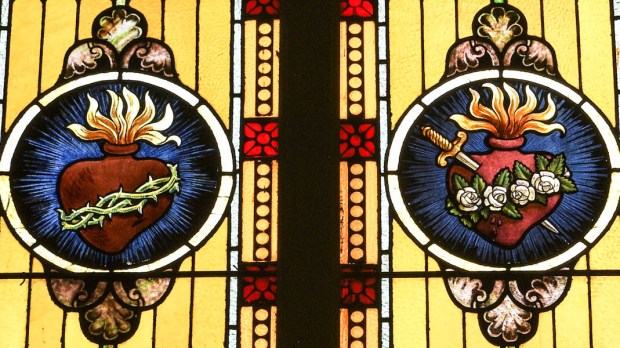The Friday following the Sunday following the Thursday following Trinity Sunday is a great solemnity in our Church, its date easier to remember now that we have Instagram and Facebook feeds filled with images of the Sacred Heart on that moveable feast. On the Solemnity of the Sacred Heart, we contemplate the pierced heart of Christ burning with love for his people, surrounded by a crown of thorns as he continues to suffer for love of us.
The following day (June 9, this year) is the feast of the Immaculate Heart of Mary. These two celebrations always come back to back, with nothing separating the heart of Jesus from the heart of his mother. Their hearts were united from the moment the divine heart began to beat in his mother’s womb, nestled below her virginal heart. They were united in suffering on Calvary, united in exultation on Easter, and united in eternity when God raised his mother’s heart into heaven to beat alongside his.
So when we meditate on the Sacred Heart, pondering the depth of God’s love for us, we need to contemplate the Immaculate Heart as well to see the response we’re invited to make with our lives.
In images of the Immaculate Heart, Mary’s heart is shown outside her body, as she gestures to it. Mary’s heart is entirely given over to the Lord, in love of him and of his people. Her heart burns with love for God, a love that pours out to the billions of children she has been called to mother. When we look on the burning heart of Jesus, we remember that our God is a consuming fire (Heb 12:29), burning away our imperfections in the power of his love that will never be deterred. When we look on Mary’s heart, we long to love the Lord with the all-consuming intensity of Our Lady. We seek to look on our brothers and sisters with that love, one that manifests itself not in word or speech but in deed and truth (1 Jn 3:18).
Next, our eyes travel to the crowns that surround the Sacred and Immaculate Hearts. Jesus’ is the same thorny crown pressed into his sinless brow, a sign of the pain and mockery he suffered on Calvary and suffers today. This, too, speaks of his love for his people, that he would so gladly suffer indignity and torture to bring home one lost sheep.
Mary’s heart, on the other hand, is wreathed in roses, a testimony to her purity. But roses have thorns, witnessing to the mortification required of anyone who seeks to imitate her purity. When held up against the backdrop of the crown of thorns, it’s easy to see how our small sufferings, when accepted for love of God, can be transformed into a thing of beauty. The Immaculate Heart, then, invites us to purity, mortification, and joy in our sacrifice.
Finally, Jesus’ heart is scarred, sliced open where the soldier’s lance pierced him after he died. The Resurrection wasn’t a divine do-over, or his wounds would have been healed when he rose. And it wasn’t just as a sign to Thomas that he rose with holes; instead, each of us can take hope from his still-wounded body that our wounds can be not just erased but glorified. As Jesus sits at the right hand of the Father, he looks at the holes in his hands, of which Isaiah prophesied, “See, upon the palms of my hands I have written your name” (Is 49:16). Jesus looks at these wounds and rejoices that by them, we have been healed (Is 53:5).

Read more:
“God has tattooed my name on his hand!” Pope Francis is blown away by God’s mercy
In Mary’s heart, there is a sword (or seven), in fulfillment of Simeon’s prophecy that a sword would pierce her heart. These swords represent the seven sorrows of Mary, the deep suffering that threatened to destroy her. More than the thorns of small sacrifices, these are the agonizing pains that we struggle under, the loss and loneliness and fear that leave us near despair. But in Mary’s heart, these swords, too, have been glorified. She doesn’t shriek in anguish, deny her suffering, or attempt to pry the swords out; she looks to her Son who suffered far more and unites her heart to his, offering him her pain. We, too, must acknowledge the deep pain in our lives, pain that sometimes comes directly from our decision to follow Jesus, and offer it to him, trusting that when we embrace our crosses, he can make us saints.
In 1942, Pope Pius XII consecrated the entire world to Jesus through the Immaculate Heart of Mary. Many individuals have done the same. As we celebrate her feast day today, let’s ask her once again to intercede that our hearts would be made more like hers in imitation of her Son.

